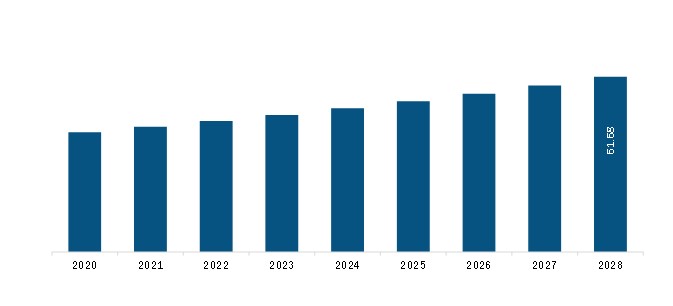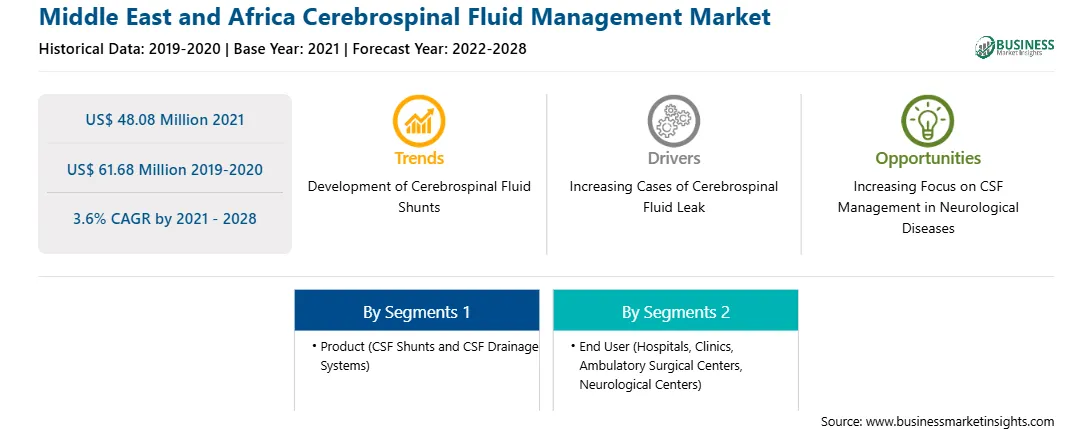The growth of the market is attributed to the increasing incidence of cerebrospinal fluid (CSF) leaks and growing developments for CSF management products. However, the risk associated with CSF shunts hinders the market growth.
The never-ending technological developments are the unstoppable trend for the growth of CSF management market. The risk of diagnosing and treatment failure, limited control options, and complications have offered various opportunities for the product developers. Rising advancements in technology have introduced the concept of “smart shunt” that could offer hi-tech control, diagnosis, and communication-based shunts or implants. It is anticipated that designed smart shunts can control CSF drainage based on feedback from one or more measured conditions. Additionally, researchers expect that smart shunts have the potential to offer sophisticated control over mechanical shunts—data with respect to shunt malfunction. It is further expected to reduce the risk of shunt obstructions and eventually reduce the risk of failures.
Late-stage development companies operating in the market are demanding experimental results to seek approvals and commercialize the smart shunts. The primary focus is on shunts designed to assess ICP noninvasively in the physician’s office through an implanted pressure sensor and noninvasive assessment of CSF flow in the clinical settings. These on-demand sensing systems will be a significantly advanced supplement to existing mechanical valves.
The growing demand for better treatments has resulted in various product developments, resulting in the Middle East and Africa cerebrospinal fluid management market growth. For instance, in July 2018, FDA granted breakthrough device designation to F. Hoffmann-La Roche Ltd for its Elecsys ß-Amyloid (1-42) CSF and Elecsys Phospho-Tau (181P) CSF. The products are used as in-vitro diagnostic immunoassays to measure ß-Amyloid (1-42) and Phospho-Tau concentrations in CSF among adults with cognitive impairment. They are evaluated for Alzheimer’s disease (AD) and other causes of dementia.
The COVID-19 pandemic is causing turbulence to the economies of Middle East. For instance, countries such as Syria, Libya, and Yemen are suffering violent conflicts and cannot implement robust public health measures. A sudden drop in domestic and external demand for goods and products, especially crude oil, and halted production due to labor shortage are major impacts observed in the region.
Furthermore, with widespread of the pandemic, various conferences organized by neurological societies and associations have been postponed or cancelled. The COVID-19 pandemic is further expected to stretch resources of already fragile neurosurgical systems in developing countries.

Strategic insights for the Middle East and Africa Cerebrospinal Fluid Management provides data-driven analysis of the industry landscape, including current trends, key players, and regional nuances. These insights offer actionable recommendations, enabling readers to differentiate themselves from competitors by identifying untapped segments or developing unique value propositions. Leveraging data analytics, these insights help industry players anticipate the market shifts, whether investors, manufacturers, or other stakeholders. A future-oriented perspective is essential, helping stakeholders anticipate market shifts and position themselves for long-term success in this dynamic region. Ultimately, effective strategic insights empower readers to make informed decisions that drive profitability and achieve their business objectives within the market.

| Report Attribute | Details |
|---|---|
| Market size in 2021 | US$ 48.08 Million |
| Market Size by 2028 | US$ 61.68 Million |
| Global CAGR (2021 - 2028) | 3.6% |
| Historical Data | 2019-2020 |
| Forecast period | 2022-2028 |
| Segments Covered |
By Product
|
| Regions and Countries Covered | Middle East and Africa
|
| Market leaders and key company profiles |
The geographic scope of the Middle East and Africa Cerebrospinal Fluid Management refers to the specific areas in which a business operates and competes. Understanding local distinctions, such as diverse consumer preferences (e.g., demand for specific plug types or battery backup durations), varying economic conditions, and regulatory environments, is crucial for tailoring strategies to specific markets. Businesses can expand their reach by identifying underserved areas or adapting their offerings to meet local demands. A clear market focus allows for more effective resource allocation, targeted marketing campaigns, and better positioning against local competitors, ultimately driving growth in those targeted areas.

The Middle East and Africa Cerebrospinal Fluid Management Market is valued at US$ 48.08 Million in 2021, it is projected to reach US$ 61.68 Million by 2028.
As per our report Middle East and Africa Cerebrospinal Fluid Management Market, the market size is valued at US$ 48.08 Million in 2021, projecting it to reach US$ 61.68 Million by 2028. This translates to a CAGR of approximately 3.6% during the forecast period.
The Middle East and Africa Cerebrospinal Fluid Management Market report typically cover these key segments-
The historic period, base year, and forecast period can vary slightly depending on the specific market research report. However, for the Middle East and Africa Cerebrospinal Fluid Management Market report:
The Middle East and Africa Cerebrospinal Fluid Management Market is populated by several key players, each contributing to its growth and innovation. Some of the major players include:
The Middle East and Africa Cerebrospinal Fluid Management Market report is valuable for diverse stakeholders, including:
Essentially, anyone involved in or considering involvement in the Middle East and Africa Cerebrospinal Fluid Management Market value chain can benefit from the information contained in a comprehensive market report.